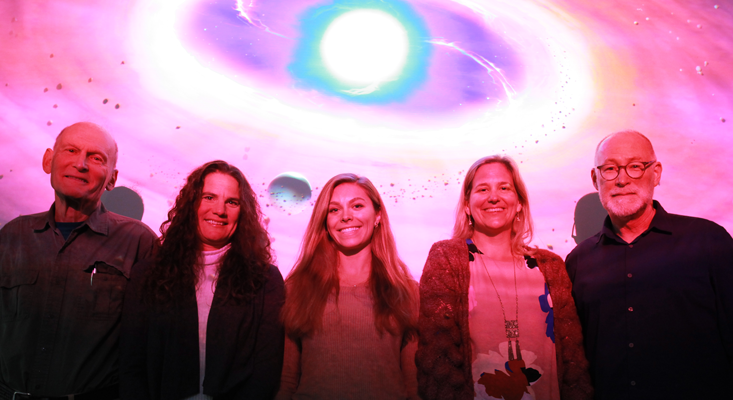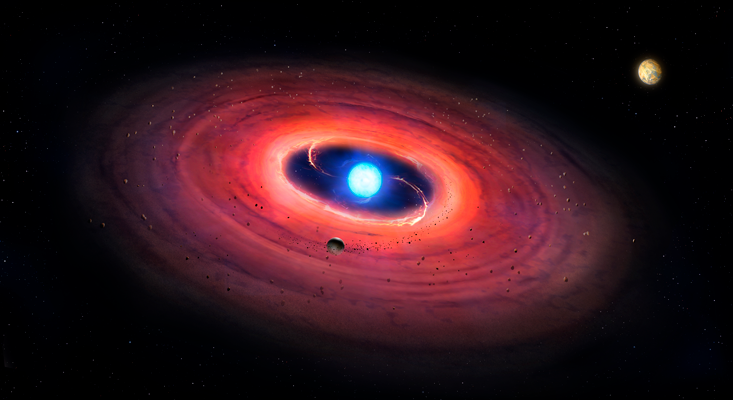Is our planet unique? The chances are slim. There are trillions of other galaxies, each of which has billions of suns. In a recent interview, Ed Young, a professor of geochemistry and cosmochemistry at the University of California, Los Angeles, tells me it may be a toss up whether a sun has a rocky planet orbiting it. But astronomers have now identified, according to NASA, more than 4,000 exoplanets, bodies orbiting a sun other than our own. “The odds are slowly increasing that other Earths exist out there,” Young says.
Young himself has boosted the odds. In a Science paper published this month with the unwieldy title, “Oxygen fugacities of extrasolar rocks: Evidence for an Earth-like geochemistry of exoplanets,” Young and his coauthors, employing a refined method of gauging the makeup of exoplanets, conclude “that at least some rocky exoplanets are geophysically and geochemically similar to Earth.” Young and one of his coauthors, Alexandra Doyle, a graduate student in astrochemistry, detailed in our conversation—doing a fine job defining technical terms—what makes their study unique and how it offers solid proof that Earth is not alone.

You say you’re doing “real” astronomical geochemistry. Why?
Alexandra Doyle: When people are trying to study the geochemistry of exoplanets, they’re mostly measuring the object’s mass and radius. They’re trying to see how much of the body is a core versus how much is a mantle and a crust, and trying to make statements about what the body looks like overall, based on those two measurements. It is very difficult because there are assumptions you have to make. For instance, oxygen in a sun-like star is very abundant. It’s the third most abundant element, but in the rocks it’s extremely volatile, so it’s hard to condense it into a rock. So you have to assume what percentage of the star’s oxygen has condensed into a rock. It’s hard to do.
Ed Young: It’s hard to find good solid evidence for other Earths. There’s a lot of circumstantial evidence. But we’re finding more rocky planets, and we found a few rocky planets in what’s called the habitable zone, where they’re the right distance from the star to have liquid water on their surface. This is real geochemistry because it measures the composition of the planets rather than just infers them.
The odds are slowly increasing that other Earths exist out there.
What are you doing differently to advance our understanding of exoplanets?
Doyle: We’re doing optical spectroscopy, observing stars in the optical spectrum. These elements that are falling into the stars—the iron, silicon, magnesium, et cetera—will absorb the light that the star is emitting, and you can actually see that in a spectrum. It will block the light at a specific wavelength for each element that you’re seeing. These wavelengths have been known for hundreds of years. These absorption lines can tell what elements are falling into the star, and you can model how abundant these elements are.
The heart of your work is the measurement of “oxygen fugacity.” Mind breaking down what that is?
Young: Sure. Fugacity is a chemistry word for partial pressure. What we’re calculating is the partial pressure of oxygen that existed when the rocks were formed. The air that you breathe, for example, is 20 percent oxygen, so we would say the partial pressure of oxygen in air is 20 percent of an atmosphere, 0.2 atmospheres. We can measure that because iron wants to be metal. Iron is going to be metal left to its own devices. But, in the presence of oxygen, oxygen will rob electrons from iron, and then oxygen and iron have to share those electrons—they make an oxygen-iron bond. So the iron is no longer existing as iron metal but as rock.
We’re using the iron content of the rock to back-calculate what the partial pressure of oxygen gas was when the rock was formed. The amount of iron that’s in the rocky outer part of the planet as opposed to the metal core is a telltale sign of what the oxygen partial pressure was when you made the rock. The record of it is the concentration of iron in the rock: how many grams of iron you have relative to how many grams of silicon, magnesium, calcium, and other things. It’s not going to go into space and it’s not going to go back into the core. The record is there as long as the planet exists.
Why is it important to know the oxygen fugacity of a rock when it formed?
Doyle: Oxygen fugacity influences planetary structure and evolution. It’s as important as pressure and temperature in determining what sort of minerals are dominant in the interiors of a planet. This is important for habitability. For instance, the oxygen fugacity will determine what minor elements are in the core. We were talking about how our core is made up of iron and nickel. We think there are trace amounts of some other element there, like silicon, and that helps Earth generate a magnetic field. Magnetic fields are extremely important for habitability of a planet. Oxygen fugacity will also affect whether you get plate tectonics, and what kind of volcanism and atmosphere you have.
Young: People have argued that the existence of plate tectonics may have been essential for the formation of complex life on earth. These are difficult arguments to capture in a sentence or two, but it’s a theme that runs through the field of astrobiology. Our study is several steps removed from that, but it’s saying if oxygen fugacity controls plate tectonics, and plate tectonics is essential for life, well, this enhances the odds that we would find habitable planets. It’s a chain of logic.

Are you arguing that exoplanets are more likely than not to have Earth-like geochemistry?
Young: Our argument is that this enhances the likelihood that there are Earth-like exoplanets. Since we’re finding oxygen fugacities that look like those on Earth or Mars, that means there must be planets like ours out there.
Where does a planet get its oxygen fugacity?
Young: As the sun is finishing up its formation, there’s a disc of gas and dust around it—a protoplanetary disc—and rocks form out of that disc by coagulation of dust and some condensation of minerals out of the hot gas. The oxygen fugacity is set in that protoplanetary disk as the rocks are forming. The disk should mostly look like the sun in composition—mostly hydrogen, followed by helium, then oxygen. But the oxygen fugacities set by the composition of the sun is at least 10,000 times lower than what we see in our rocky planets, with the exception of Mercury. Mars and Earth are 10,000 times more oxidized than what the sun’s composition would predict. So something happens when you make the planets to increase the oxidation state of the environment where they formed.
Our sun will expand and gobble up Mercury and Venus and maybe Earth.
Doyle: There are different hypotheses for what this process could actually be. What we’re seeing is that whatever the process is that oxidizes these rocks, relative to a solar gas, is happening in other planetary systems as well.
Young: And it enhances the odds that there’s Earth-like planets elsewhere because whatever that process is, it’s happening around other stars as well.
Understanding “white dwarfs” is key to your research. What is a white dwarf?
Doyle: A white dwarf star is the last known phase of stellar evolution for stars about the size of the sun. So when the sun dies, they will evolve into white dwarfs. During this evolution it can be very chaotic for the planetary systems surrounding the star. Some of the estimates for when our sun dies and evolves into a white dwarf suggest our sun will expand into a red giant and gobble up Mercury and Venus and maybe Earth.
The orbits of things like asteroids are going to be sent on very strange trajectories. By the time the star evolves and collapses down into a white dwarf, it might have asteroids swung at it. Then, if an asteroid or planetary body comes too close to the white dwarf, it will be shredded into a disc and that material will start to fall onto the white dwarf. When we’re observing these stars, a lot of them are what we call polluted. They show elements like iron, silicon, magnesium, all of these elements that are necessary to form rock. We’re seeing the chemical makeup of the rocks themselves, which is a really unique thing for exoplanet studies.
So because white dwarfs act as a sink for all this material in the solar system, they offer a unique picture of what exoplanets are made of?
Young: Correct. In reality, we’re probably seeing either fragments of planets or asteroids that went to make planets.
What’s it like looking so far away and seeing planets that seem so similar to our own?
Doyle: It’s reassuring. Reassuring in the sense that the geochemistry that we can do on rocks in Earth or in rocks in our solar system, we can also do on bodies and other solar systems.
Young: Also, we think it’s really cool.
Brian Gallagher is the editor of Facts So Romantic, the Nautilus blog. Follow him on Twitter @BSGallagher.
Lead image courtesy of NASA/JPL-Caltech


























